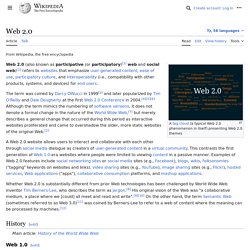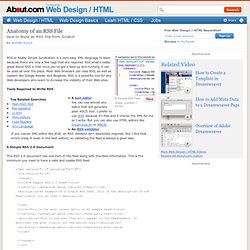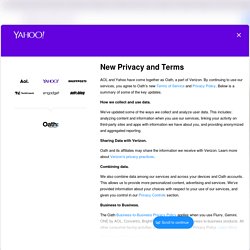

RSS & news agregator. PHP RSS Reader - RSS News Aggregator Script. Dashboard in blocks. Web & appli agregator. News agregator. Social Feed Reader. Web feed reader. Social RSS reader. Customisable start page! Portal RSS agregator. RSS portal. Web 2.0. World Wide Web sites that use technology beyond the static pages of earlier Web sites A tag cloud (a typical Web 2.0 phenomenon in itself) presenting Web 2.0 themes Web 2.0 (also known as participative (or participatory)[1] web and social web)[2] refers to websites that emphasize user-generated content, ease of use, participatory culture and interoperability (i.e., compatible with other products, systems, and devices) for end users.

The term was coined by Darcy DiNucci in 1999[3] and later popularized by Tim O'Reilly and Dale Dougherty at the first O'Reilly Media Web 2.0 Conference in late 2004.[4][5][6] Although the term mimics the numbering of software versions, it does not denote a formal change in the nature of the World Wide Web, but merely describes a general change that occurred during this period as interactive websites proliferated and came to overshadow the older, more static websites of the original Web.[7] History[edit] Wikipedia : RSS. RSS (Rich Site Summary); originally RDF Site Summary; often dubbed Really Simple Syndication, uses a family of standard web feed formats[2] to publish frequently updated information: blog entries, news headlines, audio, video.
An RSS document (called "feed", "web feed",[3] or "channel") includes full or summarized text, and metadata, like publishing date and author's name. RSS feeds enable publishers to syndicate data automatically. A standard XML file format ensures compatibility with many different machines/programs. RSS feeds also benefit users who want to receive timely updates from favourite websites or to aggregate data from many sites. Subscribing to a website RSS removes the need for the user to manually check the web site for new content.
Software termed "RSS reader", "aggregator", or "feed reader", which can be web-based, desktop-based, or mobile-device-based, present RSS feed data to users. History[edit] In September 2004, Stephen Horlander created the now ubiquitous RSS icon ( Anatomy of an RSS File. RSS or Really Simple Syndication is a very easy XML language to learn because there are only a few tags that are required.

And what's really great about RSS is that once you've got a feed up and running, it can be used all over the place. Most Web browsers can read RSS, as well as readers like Google Reader and Bloglines. RSS is a powerful tool for any Web developers who want to increase the visibility of their Web sites. Tools Required to Write RSS A text editor You can use almost any editor that will generate plain ASCII text. A Simple RSS 2.0 Document This RSS 2.0 document has one item in the feed along with the feed information. <? As you can see, a basic RSS document has very little required to create a fully functional feed.
The first three lines tell the user agent that this is an XML document, it's an RSS 2.0 file, and there is a channel: The version information isn't required, but I find that it's a good idea to include that attribute on the <rss> tag. <guid> Add New Items to the Top. RSS tutorial: building and using a feed, step by step. Building and Using an RSS Feed by Denis Sureau What is RSS? It is a format to share data, defined in the 1.0 version of XML. You can deliver information in this format et one can get this information, and information from other various sources, in this format. Wikipedia : Netvibes. Netvibes is a personalized dashboard publishing platform for the Web composed of widgets that are pulled from a widget list open to third party developers. Common uses: Brand Monitoring – to track clients, customers and competitors across media sources all in one place, analyze live results with 3rd party reporting tools, and provide media monitoring dashboards for brand clients.E-Reputation Management – to visualize real-time conversations and social activity feeds, and track new trending topics.Product Marketing – to create interactive product microsites, with drag-and-drop publishing interface.Community Portals – to engage online communitiesPersonalized Workspaces – to gather all essential company updates to support specific divisions (e.g. sales, marketing, HR) and localizations.
History[edit] The company was founded by Tariq Krim and Florent Frémont in 2005. In August 2006, Netvibes closed a funding round of €12 million led by Accel Partners in London along with Index Ventures.
RSS portal. Protopage. RSS reader and more. News aggregator. Personalized web page. AOL and Yahoo have come together as Oath, a part of Verizon.

By continuing to use our services, you agree to Oath’s new Terms of Service and Privacy Policy. Below is a summary of some of the key updates. How we collect and use data. We’ve updated some of the ways we collect and analyze user data. This includes: analyzing content and information when you use our services, linking your activity on third-party sites and apps with information we have about you, and providing anonymized and aggregated reporting. Sharing Data with Verizon. Oath and its affiliates may share the information we receive with Verizon. Combining data. We also combine data among our services and across your devices and Oath accounts. Business to Business. The Oath Business-to-Business Privacy Policy applies when you use Flurry, Gemini, ONE by AOL, Convertro, BrightRoll or any other Oath business-to-business products. Key Points in Terms of Service. The news in your life.